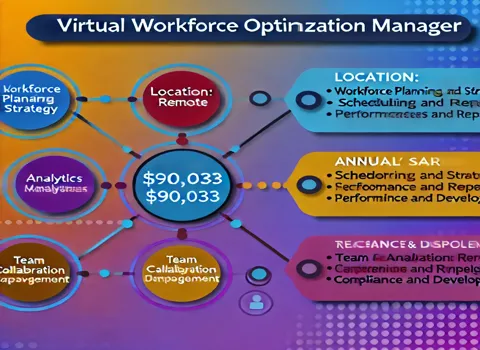Virtual Workforce Optimization Manager
Location: Remote
Annual Salary: $90,033
Job Summary:
As a Virtual Workforce Optimization Manager, you will enhance a remote team's efficiency, performance, and productivity. You will analyze, plan, and manage workforce operations to align staffing levels with business needs, ensuring optimal resource allocation and maximizing output. This position requires a strong understanding of remote work dynamics, data analytics, and advanced workforce management techniques. You will also optimize scheduling, forecast demand, and maintain strong communication channels within a virtual environment.
Key Responsibilities:
- Workforce Planning and Strategy:
- Develop and implement workforce optimization strategies to meet organizational goals and client expectations.
- Collaborate with senior management to assess the virtual workforce's current state and identify areas for improvement.
- Use data-driven insights to forecast workload requirements, ensuring staffing levels are appropriately aligned with operational demands.
- Anticipate future workforce needs and design strategies to recruit, onboard, and train virtual team members accordingly.
- Scheduling and Resource Management:
- Oversee scheduling and ensure proper shift coverage by coordinating work schedules for remote team members.
- Analyze patterns in employee availability, workloads, and time-off requests to create schedules that balance team capacity and individual productivity.
- Monitor attendance, breaks, and shifts to ensure compliance with company policies and legal regulations.
- Implement contingency plans to manage workforce disruptions, such as system outages, natural disasters, or unexpected changes in staffing needs.
- Performance Analytics and Reporting:
- Utilize workforce management software and other tools to track employee productivity and performance metrics.
- Design and maintain dashboards and reports that provide insights into team performance, identifying areas where productivity can be enhanced.
- Conduct regular performance reviews and create action plans to address areas of improvement.
- Use predictive analytics to forecast future performance challenges and mitigate risks to operations.
- Process Improvement:
- Continuously seek ways to improve remote workforce processes, aiming for enhanced efficiency, reduced costs, and improved service quality.
- Engage with cross-functional teams, including HR, operations, and IT, to drive process improvements across the organization.
- Identify bottlenecks in current operations and recommend adjustments to tools, workflows, and communication strategies.
- Lead or support initiatives related to automation, AI integration, and other technologies that can further optimize workforce management.
- Team Collaboration and Communication:
- Foster a culture of open communication within the virtual workforce, ensuring team members feel connected and engaged despite working remotely.
- Collaborative tools like video conferencing, project management software, and instant messaging platforms can streamline team communication.
- Act as a liaison between team members and management to address concerns, share updates, and ensure alignment with organizational goals.
- Establish and maintain regular virtual meetings with teams to discuss performance updates, answer questions, and promote team cohesion.
- Training and Development:
- Identify training needs within the remote workforce and work with HR or learning and development teams to design effective training programs.
- Provide coaching and mentoring to team members, fostering a continuous learning environment.
- Ensure new team members are adequately onboarded and trained in workforce management tools, processes, and best practices.
- Develop succession planning strategies for key roles within the virtual workforce.
- Compliance and Risk Management:
- Ensure that all remote workforce management practices comply with relevant labor laws, organizational policies, and industry standards.
- Conduct regular audits of scheduling, time tracking, and employee performance to ensure compliance and mitigate potential risks.
- In partnership with HR and legal teams, address any workforce-related legal or compliance issues, such as labor disputes or contract negotiations.
Qualifications:
- Education:
- Bachelor’s degree in business administration, operations management, human resources, or a related field. Advanced degrees or certifications in workforce management or operations are a plus.
- Experience:
- A minimum of 5 years of experience in workforce management, with a strong focus on remote or virtual teams.
- Proven experience optimizing workforce operations, scheduling, and resource allocation for large teams.
- Experience working with workforce management tools like Kronos, Verint, or equivalent software solutions.
- Skills and Competencies:
- Strong analytical and problem-solving skills with the ability to leverage data for decision-making.
- Proficiency in workforce management tools, scheduling software, and data analytics platforms.
- Excellent communication skills with the ability to engage and inspire remote teams.
- Familiarity with remote collaboration tools such as Zoom, Microsoft Teams, Slack, and project management software.
- Demonstrated leadership skills with the ability to manage a diverse virtual team across different time zones.
- Strong organizational and time management skills, with the ability to prioritize tasks and meet deadlines in a fast-paced, remote environment.
- Knowledge of labor laws, compliance regulations, and best practices in workforce management.
Work Environment:
This fully remote position requires flexible working hours to accommodate the needs of a global team. The Virtual Workforce Optimization Manager will work closely with remote teams across multiple time zones, ensuring continuous operational support and resource availability.




